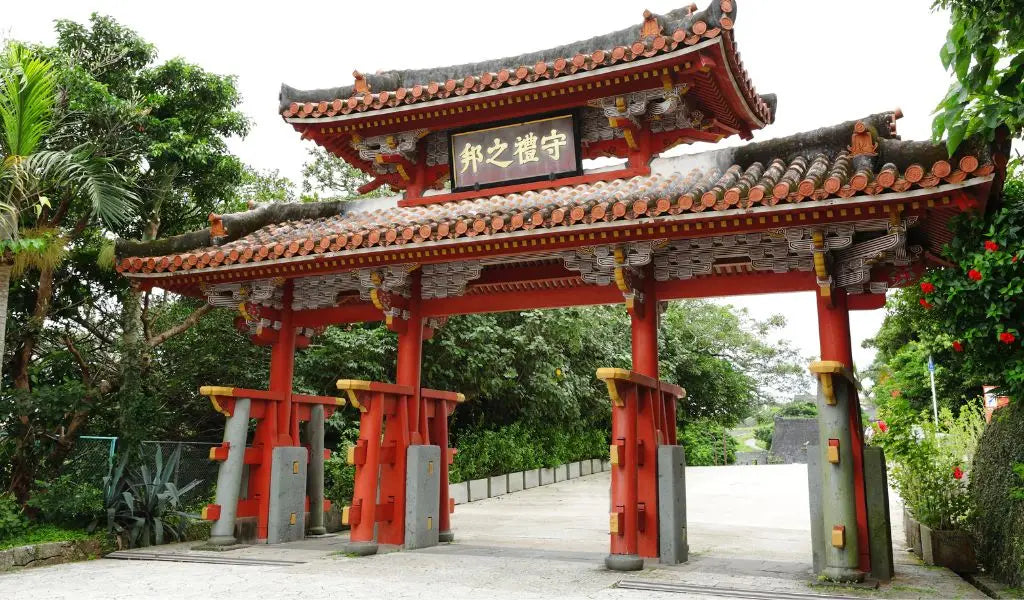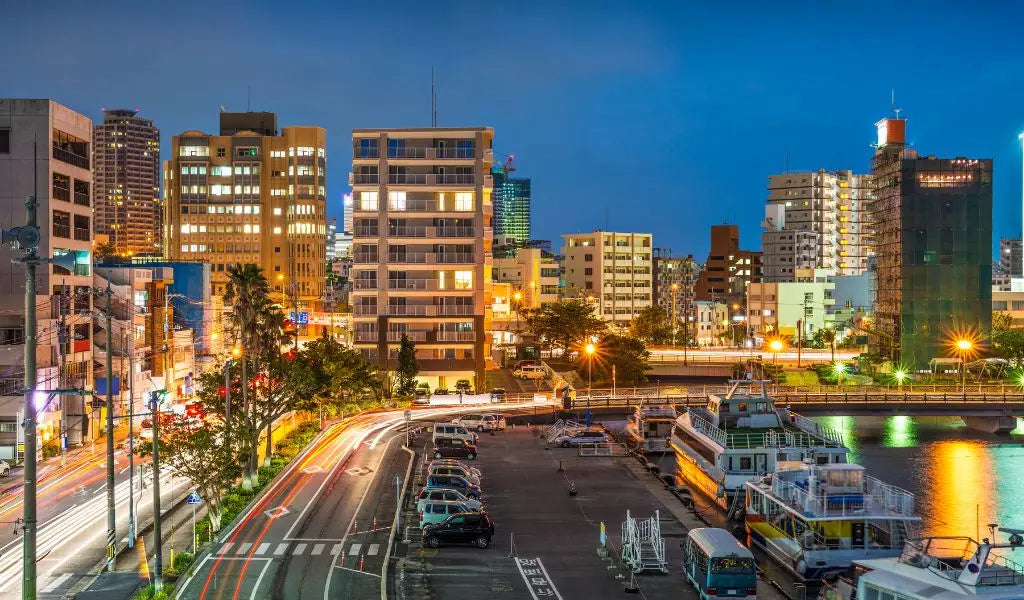Each region of Japan has its own attractions, treasures, and discoveries. But when a destination is too far from Tokyo, it may seem inaccessible to some.
Some only know Okinawa through the lens of World War II. Others imagine this tropical island as a distant paradise closed to the general public. Think again. Okinawa, a territory with precious traditions where the inhabitants enjoy a record-breaking life expectancy, could very well be your next vacation destination.
How to get to Okinawa and fully enjoy Japanese Hawaii? Let's escape and explore the richness of tropical Japan together.
History of Okinawa, the Japanese tropical paradise

Marine Corps Air Station Futenma. Source: Wikipedia
A destination rich in traditions
In the 15th century, the Okinawan archipelago was a Chinese vassal state called the Ryukyu Kingdom and maintained trade with China and Korea. Later annexed by Japan, the kingdom became Okinawa Prefecture in 1901. As a result, the archipelago boasts a distinctive and preserved culture with multiple influences: Chinese, Korean, Polynesian, and more.
The island of Okinawa was occupied by the American military until 1972, after enduring one of the bloodiest battles of World War II that destroyed a significant part of the island and killed a quarter of its population. Some traces of this painful past remain, such as military bases on the territory.
However, the Okinawans have managed to preserve various ancestral customs, such as their dialect, Okinawa-ben. To greet someone, you won't say "konnichiwa" but "haisai".

The Shureimon Gate.
Okinawa boasts nine archaeological sites inscribed as World Heritage Sites, thanks to the legacy left by the Ryukyu Kingdom. The archipelago is dotted with numerous castles and sacred shrines. You can also attend traditional singing concerts accompanied by the sanshin instrument and a folk dance called eisa odori.
During the O-Bon festival, you can have a special experience: be captivated by the drums, songs, and connect with ancestral spirits.
The longevity of the Okinawan inhabitants
Okinawa Prefecture and its paradise-like landscapes offer an exceptional living environment. Proof of this is that the Okinawans have set a record for the highest number of centenarians within their population.
Locals indeed have a diet based on low-energy-density foods (green vegetables, tofu, fresh seaweed, tea, water, citrus fruits, soy milk, etc.). Read our article on the "8 Secrets of Japanese Longevity" to be inspired by their healthy habits.
Their cuisine is worth a try! Taste their specialties like the famous bitter melon Goya champuru or Okinawa soba noodle soup with local tuna and seaweed. You'll have access to dishes you won't find anywhere else in Japan.
Here's a guide to Japanese regional popular food, so you can become an expert on the subject.
Moreover, they are much closer to nature than a city dweller in Tokyo, for example. They are surrounded by dense and lush vegetation and the endless blue expanse of the East China Sea.
Thanks to the semi-tropical climate of the archipelago, Okinawans enjoy a unique quality of life throughout the year. The temperature averages 22°C, allowing residents to swim from January to December. The water can reach up to 29°C and rarely drops below 21°C. Now you understand why Okinawa is called the "Japanese Hawaii"!
How to Enjoy the Beautiful Okinawan Islands

Kerama island
Tips for Traveling Peacefully in Okinawa
This archipelago is one of the favorite destinations for Japanese people when they need a sunny vacation. It comprises more than 160 different islands! Here are the four essential areas that we highly recommend you explore:
- Okinawa Honto : The main island of Okinawa, home to the city of Naha, the capital of the archipelago. It hosts the majority of cultural activities, large hotels, and shopping centers. You'll find monuments related to World War II, the Yanbaru National Park, and the Tamagusuku Castle.
- Kerama Islands : Take the ferry from Naha to admire breathtaking tropical landscapes. Dive into its crystal-clear waters and stroll along its paradisiacal beaches and national park.
- Yaeyama Islands : Perfect for a change of scenery and visiting traditional Japanese countryside villages. In Ishigami, you'll have the chance to see the Oganzaki lighthouse, hike in the subtropical forest, and encounter the monkeys of Yaimamura. Easily accessible by plane.
- Miyako Islands : Admire the sugarcane fields of Miyakojima and take its unforgettable coastal trails. The perfect place to taste Okinawan culinary specialties.

Miyako islands
Many people hesitate to visit Okinawa out of fear that they may not be able to get around the island or even set foot on it. However, Naha is accessible by plane from Tokyo in less than a three-hour flight. It is also possible to reach it by ferry from Japan, but we don't really recommend it due to the length of the journey.
The best way to explore the various activities in Okinawa is to rent a car once you're there. If you don't have an international driver's license, you can still use the bus lines.
The ideal time to enjoy Okinawa depends on your ability to handle the heat. If you tend to struggle with high temperatures in July and August in France, it's best to avoid visiting the archipelago in the summer! Temperatures can rise up to 31°C. The rest of the year, it's pure bliss. In Okinawa, cherry blossoms bloom as early as January.
Top 10 things to do on the island

Churaumi aquarium
1. Archaeological VisitsTravel back in time to the Ryukyu Kingdom. Explore the ruins of four once magnificent castles: Nakagusuku, Zakimi, Nakijin, and Katsuren. The Shinto shrine Sefa-utaki is a UNESCO World Heritage Site hidden among impressive rock formations. Don't forget the Shurijo Castle, restored in 1992.
2. Scuba DivingIn 1985, the remains of a prehistoric city were supposedly discovered underwater... It's your turn to make a historic find! Aragusuku Beach is ideal for snorkeling.
3. Beach SwimmingThere's nothing better than the sea to relax after all the sightseeing. The most famous beach is Yonaha Maehama.
4. O-Bon FestivalIn mid-July, the Okinawans pay tribute to the deceased and their ancestors through Buddhist rituals accompanied by traditional dances and songs.
5. Makishi MarketLocated in Naha, this market offers fresh local products as well as restaurants to taste Okinawa's unique cuisine.
6. Hiking in Subtropical ForestsOkinawa is home to Japan's largest subtropical forest. In the Yanbaru National Park, you can also follow the Gesashi River.
7. Discovering CraftsmanshipFeel free to visit pottery or glass workshops in typical villages.
8. Ocean Expo ParkYou can't miss the Churaumi Aquarium with its 21,000 marine creatures.
9. Peace Memorial ParkBuilt 50 years after the 1945 Battle of Okinawa, in memory of the victims. You'll also find the Okinawa Memorial Museum and the Peace Bell.
10. Mihama American VillageAn amusement park with a shopping center, a Ferris wheel, restaurants, and play areas.

Naha - Okinawa
All that's left for you to do is to take a plane to enjoy this way of life and, who knows, increase your longevity! The sunny island of centenarians will relax you while allowing you to explore its unique history and traditions. It's even said that Okinawa is the birthplace of karate.
To cool off a bit and continue your journey, here's our article on Hokkaido, the northern island of Japan.



